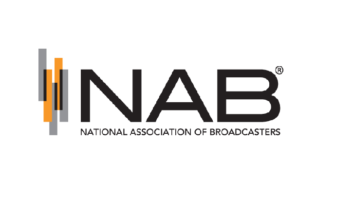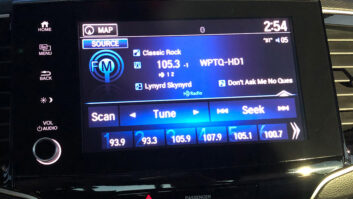(click thumbnail)Andy: The ASI6544 multistream PCI sound card from AudioScience fills a void in the market between large multi-track recording interfaces and two-channel stereo cards found in many production rooms.
Allowing for eight simultaneous mono inputs, the 6544 could pair up perfectly with an eight-bus console in a “live room,” allowing some flexibility during post. For example, the 6544 would shine on a pre-recorded panel discussion, allowing eight separate voices to be recorded and then mixed later.
The card itself is easy to install and the audio cables are labeled well. I personally would prefer a breakout box to the cable-based breakouts supplied for testing, but this is aesthetics (the company says it does provide one); the cables all worked flawlessly.
The audio quality of this card is what you would expect from AudioScience, definitely in the upper echelon of converters. The ASI Mixer and routing software gives great metering with peak and RMS readouts. The software gives clear and concise control over the card’s parameters.
It is worth mentioning that the ASI6544 allows you to run analog and digital at the same time, just not on the same input. The card has eight mono voices on input so any combination of stereo analog, mono analog, AES or S/PDIF can be used as long as only eight of the card’s voice paths are used.
Note: You can digitally mix streams of different sample rates and formats, thanks to the on-board MRX multi-rate mixing technology. AES/EBU inputs have sample rate converters too. On output, it can provide 12 playback channels that are essentially routed to one of the four stereo outputs.
Ready to play
With this amount of ins and outs, this card is well suited out of the box to play in the broadcast automation world. There are WDM, WAV, Vista and Linux drivers supplied for all 6000 series cards, making it compatible with many software applications. As always, check with your particular supplier on compatibility before purchasing.
In addition to the aforementioned drivers, this card has ASIO (Audio Stream In/Out) support, making it a great compliment to many of the new multi-track software suites such as Adobe Audition 2.0, Steinberg Cubase and many other multi-track applications. Note that the 6544 is not OSX-compatible, nor is it supported by Digidesign’s ProTools.
From an emerging applications aspect, the true calling of the 6544 is surround sound. Mixing in 5.1 surround requires six independent mono audio channels for left, right, center, rear left, rear right and the LFE channel. The 6544 shines in this realm, boasting enough channels for the surround mix with its SSX2 mode and also giving the extra two channels for a supplementary stereo mix.
To sum it up, the ASI6544 is a first-class audio card. The driver support and ASI software is great. The lack of Apple OSX drivers isn’t too disappointing, as most of the big OSX players (ProTools, Digital Performer, Logic) are using proprietary interfaces. It is refreshing in these days of USB 2.0 and FireWire to see companies like AudioScience still releasing quality PCI-based audio cards.
Second set of eyes
Colin: The ASI6544 went into an available PCI slot in a new run-of-the-mill standard-issue HP dc7700. The machine has a 3.4 GHz processor, 1 GB of RAM and a 160 GB hard drive, and is running on Microsoft XP-Pro SP2 O.S. No driver was provided in the box but a quick visit to the ASI Website remedied the situation.
Product CapsuleASI6544 Multistream PCI Sound Card
Thumbs Up

- Great sound quality
- Plenty of ins and outs
- Superb metering in the driver
- Flexible routing software
- Multi-rate mixing technology
- TSX time scaling
Thumbs Down
- Can’t run A/D simultaneously on the same input
Lots of XLRs hanging off cables
Price
$3,495
Contact
AudioScience in Delaware | (302) 324-5333 | www.audioscience.com.I chose the WDM driver for XP, which has ASIO support. It installed flawlessly. XP detected the card and we were off. For testing purposes we chose Adobe Audition 1.5, commonly used at radio plants.
All manner of cable-based breakouts were provided to connect the card to the outside world. We found the large amount of XLRs hanging off these cables to be a bit unwieldy. There is, however, a rack-mount solution available from ASI.
The unit has four stereo analog inputs and outputs that can be split out to eight and eight mono if desired. Also provided are four stereo digital ins and outs that can be used as S/PDIF or AES/EBU switchable in the card’s software.
We found the metering in the driver to be superb, showing both RMS and peak values with nice ballistics. The software allowed for just about any conceivable routing of the unit’s I/O. However, we noticed fairly quickly you cannot use all four analog and all four digital inputs simultaneously.
You can mix and match digital and analog but you only have four stereo/eight mono “ins,” no matter how you slice it. It would have been nice to see a separation of the card’s capability to allow four stereo analog and four stereo digital inputs at the same time. We discovered this in Adobe Audition, whereas we have seen with other cards the ability to select either the digital or analog in. But in this case you were selecting more of a “channel” that is analog or digital, but not both.
Sound quality was excellent. I’m sure it meets its published specs (110 dB SNR, 24 bit ADC/DAC).
A unique feature of this card is its ability to encode and decode MPEG Layer 2 and MP3 audio directly (native) on the card, utilizing a floating-point DSP. AudioScience states this offloads the PC’s resources for better performance. We felt there may also be a quality improvement encoding audio before it ever hits the application software.
Another impressive feature set is the TSX time scaling, which allows compression/expansion of play streams by up to +/-20 percent with no pitch shift.
Adobe Audition had no problem detecting and using all of the cards I/O.
We did feel that the ASI6544 was a card in search of a market. With only four stereo inputs and outputs, it is too much for the mixer-outfitted studio, but not enough for the full-blown computer-based production suite.












